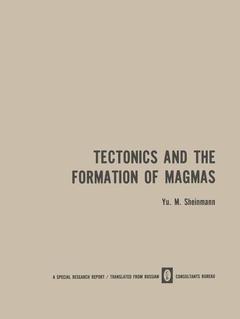Tectonics and the Formation of Magmas, 1971
Langue : Anglais
Auteur : Sheinmann Yu. M.

It is a pleasure to any author to enlarge the circle of his readers. Naturally this is a pleasure to me. At the same time, however, misgivings arise: whether these pages will con vey to the circle of new readers the thoughts that excite the author. Science is advancing rapidly in our day. It is already apparent that many things in the book should have been stated differently. I have tried to make additions to the English-language edition in such a way that they do not require great alteration of the text. I ask my new readers to remember that this book was written primarily for my fellow countrymen and that, because of this, some chapters contain descriptions of regions little known to you and information on the USSR almost unknown from other publications. I hope that, despite this, geologists who read the English-language edition will find something of interest to themselves in it and that their labor will not have been in vain. Yu. M. Sheinmann Institute of Phys ics of the Earth Moscow v PREFACE The study of endogenetic processes has long pushed us into investigation of ever deeper parts of the earth. Not long ago all attention was focused on depths where ore deposits appear, where metamorphic and igneous rocks, which later become exposed at the surface, are formed, where granites originate.
1. Introduction.- 2. What Prevents Direct Comparison of Petrologic and Tectonic Data?.- 3. The Possibility of Understanding the Tectonics of Deep-Seated Regions and a Method Proposed for Studying It.- 4. Regional Tectonic Subdivisions According to Depth.- Types of Seismic Regions.- Comparison of Seismic Regions with Tectonic Zones.- Concerning Isostatic Anomalies.- 5. Orientation of Stresses and the Geometry of Deep-Focus Earthquakes.- 6. Primary Magmas.- Lavas of Ethiopia, Syria, and Lake Kivu.- The Tertiary Brito-Arctic Province.- The Relations among Olivine-Basalt, Andesite-Basalt, and Granite Magmas.- 7. The Tectonic Distribution of Primary Magmas.- 8. The Extrageosynclinal Type of Magmatic Development.- Basaltic Magmas.- Silicic Magmas.- Alkalic and Ultrabasic Complexes.- 9. Magmatic Features of Midocean Ridges.- 10. Geosynclinal Magmas.- Geosynclines and Deep-Focus Earthquakes.- Magma from the Mantle.- Ultrabasic Rocks.- The Tectonofer.- 11. Silicic Magmas (Magma Formation in the Crust).- 12. Volcanic (Volcanic-Plutonic) Belts.- 13. Magma and the Subsidence of Ocean Basins (Concerning “Oceanization”).- 14. Conditions for the Appearance of Magma.- Basaltic Magmas.- Alkalic Basalts.- Ultrabasic Complexes.- 15. Conclusions.- Concluding Remarks for English-Language Readers.- Appendix. Tables of Chemical Analyses.- Literature Cited.
Date de parution : 02-2012
Ouvrage de 174 p.
21x27.9 cm
Mots-clés :
formation; granite; igneous rock; magma; ore deposit; tectonics
© 2024 LAVOISIER S.A.S.



